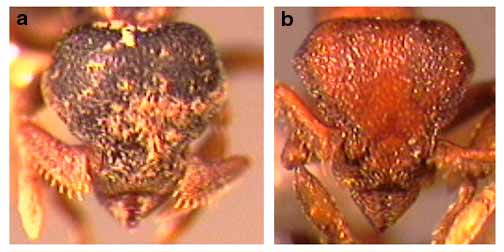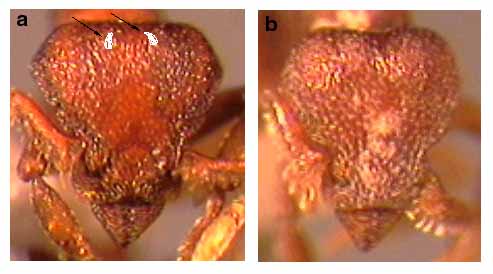
| Genus List | Species List |
The genus Octostruma is a member of the monophyletic tribe Basicerotini (Bolton 1998). Octostruma is known only from the New World tropics, from southern Mexico and the West Indies to northern Argentina (Brown and Kempf 1960). It is a part of the "cryptobiotic" fauna: small, slow-moving ants that live in rotten wood and leaf litter. The very similar genus Eurhopalothrix is known to be predaceous on small, soft-bodied arthropods (Brown and Kempf 1960, Wilson 1956, Wilson and Brown 1985).
Workers and nests are extremely difficult to see in the field. Some species camouflage themselves with layers of soil (Hoelldobler and Wilson 1986). As a result of their cryptic nature, they were considered extremely rare until the 1960's. But increasing use of Winkler and Berlese sampling has shown Octostruma to be relatively common. I encounter them in most Winkler samples from wet forest sites in Costa Rica.
Workers of some Octostruma species have an appressed "ground pilosity" of filiform to spatulate setae, and a variable number of larger, specialized erect setae on the face, mesosomal dorsum, petiole, postpetiole, and gaster. The specialized setae vary from filiform to broadly spatulate to almost pompon-like, and may be straight or curled over. Hoelldobler and Wilson (1986) found this pilosity structure to be common to many basicerotines and to the genus Stegomyrmex, calling the ground pilosity "holding hairs" and the specialized erect setae "brush hairs" (see copies of their SEM figures under Basiceros manni and Eurhopalothrix bolaui). They observed that foragers (but not younger nest workers) commonly had an encrustation of soil adhering to the body surface (figure), held in place by the holding hairs. They concluded that the soil layer served to camouflage the workers from predators such as birds and lizards, and that the adaptive significance of the bizarre pilosity was to capture soil particles (the function of the brush hairs) and adhere them to the cuticular surface (the function of the holding hairs).
Brown and Kempf (1960) revised the genus and provided keys. They were hampered by an extreme paucity of material, and from Costa Rica they knew of only four collections [1 worker cf. wheeleri from Tres Rios (A. Bierig), and collections of what they identified as balzani from Hamburg Farm (Nevermann), Santa Ana (A. Bierig), and Turrucares (A. Bierig)]. Since their revision one additional species has been described: Perrault described the species betschi from French Guiana, placing it near balzani.
I now recognize 12 "species" in Costa Rica. Four of these are in the balzani complex, and other authors might treat them as subspecies or a single polytypic species (Brown and Kempf certainly would). Four others are known from single collections, and limits of variation among them are unknown.
The characters I use in differentiating the species are face sculpture, pilosity patterns, color, and size.
Face sculpture: the face may be (1) uniformly punctate, giving the face a dull, granular look; (2) smooth and shiny; (3) irregularly rugose but rugae with distinct longitudinal orientation; (4) irregularly and feebly rugose, tops of rugae shiny, and no longitudinal orientation; and (5) smooth but dull, shagreened.
Pilosity: as described above, Octostruma workers may have two kinds of setae: ground pilosity and erect specialized setae. The erect setae, when present, usually occur in symmetrical patterns on the face, mesosoma, and gaster. The specialized setae may be lost due to wear, but one can often rely on the symmetry to see where lost setae should be.
Color: varies from light orange to dark reddish brown.
Size and proportions: Although I have not made extensive measurements, I have measured a set of variables for at least one worker of each species. The variables are:
Head length (HL): length of head measured in full face view, along median axis, from anterior border of clypeus at midline to line tangent to posteriormost lobes of vertex.
Head width (HW): width of head across widest point posterior to eyes.
10a. Face crossed by a sharp, clearly defined arcuate carina; anterior portion of face concave, differentiated from posterior portion, delimited by frontal carinae and facial arc; face and vertex lobes shiny; mesosoma short, compact; dorsal and posterior face of propodeum meeting to form broad, shallow, obtuse angles, not forming distinct acute propodeal teeth; mesosoma and gaster devoid of erect setae: JTL-010
10b. Face usually lacking an arcuate carina and differentiated anterior portion, if arcuate carina faintly present, resulting in a somewhat differentiated anterior portion, vertex lobes are punctate and opaque; propodeal teeth always well-developed, subtriangular, and forming an acute angle; pilosity variable: 100

100a. Vertex lobes uniformly punctate and opaque, never rugulose; face usually with 8 or more erect clavate setae, ground pilosity not evident; face rarely obscured by a layer of soil; mesosomal dorsum with one pair or no erect setae; HW usually less than 0.60mm: balzani complex
100b. Vertex lobes usually rugose, rugulose, or nearly smooth; if uniformly punctate and opaque, ground pilosity conspicuous, curved, clavate, subdecumbent; face sometimes obscured by layer of soil (figure); pilosity variable; HW usually greater than 0.60mm: 200

200a. First gastral tergite with about 16 erect spatulate setae; vertex lobes uniformly punctate, but often obscured by a layer of soil: JTL-004
200b. First gastral tergite with at most 4-6 erect setae; vertex lobes rugose, rugulose, or nearly smooth; face sometimes with layer of soil: 300

300a. First gastral tergite usually with 4 erect spatulate setae; first gastral tergite punctate anteriorly, grading rather abruptly to nearly smooth and shining posteriorly (puncta becoming dense again at posterior border on some specimens); face longitudinally rugose; face usually with 10 and mesosoma usually with 4 erect spatulate setae: JTL-005
300b. First gastral tergite devoid of erect setae; first gastral tergite either punctate or smooth, but sculpture relatively more even from anterior to posterior border; face longitudinally rugose to irregularly reticulate rugose; number of setae on face variable, mesosoma lacking erect setae: 400

400a. Face longitudinally rugulose, with 8 erect spatulate setae; one or two stiff setae projecting from posterior face of hind coxa, a long, fine, flexuous seta projecting laterally from near spiracle on peduncle of petiole, fine seta projecting anteroventrally from anterolateral border of postpetiole (figure): iheringi
400b. Face reticulate rugose to nearly smooth; number of erect setae on face variable; hind coxae, petiole, and postpetiole lacking specialized setae described above: 500

500a. Face with 8-10 erect clavate setae; color dark red brown; HW 0.76 (n=1): JTL-006
500b. Face with 2 erect setae or none; color variable; HW 0.58-0.81 (n=3): 600

600a. Face nearly smooth, shagreened (not shiny), with 1-3 pairs of erect setae on face; color dark red brown; HW 0.81 (n=1): wheeleri
600b. Face reticulate rugose, with one pair or no erect setae on face; color orange; HW 0.58-0.77 (n=2): 700

700a. Face with one pair erect setae near middle of face; HW 0.77 (n=1): JTL-008
700b. Face with no erect setae; HW 0.59 (n=1): JTL-009

Literature Cited
Bolton, B. 1998. Monophyly of the dacetonine tribe-group and its component tribes (Hymenoptera: Formicidae). Bulletin of the Natural History Museum London (Entomology) 67:65-78.
Brown, W. L., Jr., Kempf, W. W. 1960. A world revision of the ant tribe Basicerotini. Stud. Entomol. (n.s.) 3:161-250.
Hoelldobler, B., Wilson, E. O. 1986. Soil-binding pilosity and camouflage in ants of the tribes Basicerotini and Stegomyrmecini (Hymenoptera, Formicidae). Zoomorphology (Berl.) 106:12-20.
Perrault, G. H. 1988. Octostrumma [sic] betschi, n. sp. de Guyane Francaise (Hymenoptera, Formicidae). Revue fr. Ent., (N.S.) 10:303-307.
Wilson, E. O. 1956. Feeding behavior in the ant Rhopalothrix biroi Szabo. Psyche (Camb.) 63:21-23.
Wilson, E. O., Brown, W. L., Jr. 1985 ("1984"). Behavior of the cryptobiotic predaceous ant Eurhopalothrix heliscata, n. sp. (Hymenoptera: Formicidae: Basicerotini). Insectes Soc. 31:408-428.
Page author:
John T. Longino, The Evergreen State College, Olympia WA 98505 USA.longinoj@evergreen.edu